Year 2 Home Learning Resources
Year 2 Remote Learning- Google Classroom
Welcome to Year 2’s Remote Learning page
We are currently working on our Remote Learning resources to ensure your child has access to the full curriculum, should they be off school due to isolating.
All of these resources will be on your child's Google Classroom account.
Here are some helpful documents to explain further:
Parent Guidance for Remote Learning
How to Guide- Google Classrooms
Year 2 Home Learning Resources
Welcome to Year 2’s home learning page. We hope you are all well and looking after each other at home. Below are some suggested activities and resources and a suggested timetable that you can follow or select activities from. This is not compulsory and the activities we have provided below are simply suggestions. We want our children to be happy and mentally healthy during this period of time so find what suits your child and family; that may be daily bursts or following a structured timetable. We do not expect you to follow and complete each activity, so please feel free to pick and complete any of the activities as you wish to do so. Please also visit our 'Wellbeing' page for some activities which children can complete independently for a learning break or some quiet time. Please also refer to our 'SEN resources' for additional support for your child, should you need this.
To children - your teachers and everyone at school are really missing you. Here is a special letter we have written for you. We hope to see you soon!
Updated Year 2 Home Learning Resources – 13.07.20
Maths
Daily - White Rose maths session.
Daily maths session including a video and follow up questions/ activities. All resources will be saved onto our home learning page and accessed below. We do not expect you to complete every task here, however, each ‘step’ builds on from the next so work through them in the right order at your own pace.
Click here to go to White Rose Year 2 Home Learning
Week commencing 13th July – Please remember to ignore the dates and complete the steps in order as the ‘small steps’ follow a sequence of lessons/concepts. If you have followed the sequence of lessons so far that we have set for home learning, then you should now be onto Summer Term Week 9. All other resources for previous/ following weeks can be found on our KS1 Mathematics curriculum page.
Week 1: Summer Term Week 9
Lesson 1 – Measure Length (cm)
Lesson 2 – Compare Lengths
Lesson 3 – Four operations with length
Lesson 4 – Compare Mass
Lesson 5 – Friday Maths Challenge
Please find below the activity sheets for each day. The videos can still be accessed by following the White Rose link above.
White Rose Year 2 - Week 9 |
Weekly- Once you have completed the White Rose activities, have a go at your Mathletics challenge that your teacher has set for you at the end of each week.
Extras:
Daily – Click here to have a go at the White Rose ‘Problem of the Day’. Can you explain how you solved the problem?
Writing
Transition
- Now that you have had some time to think about your next move into Year Three, it is a good time to ask any important questions that you may have. Use the question prompt ideas to help you write your own list of questions about Year Three. Think of any worries you have or things that you are excited to know about.
- As you make the move into the Junior school, it is a special time to think about your hopes for the future. Think about all of the things that you would like to continue in Year Three and anything you would like to be able to improve upon and get better at. Use the template to help you to present your hopes for the future.
- Think about all of the things that made you happy in your Year Two classroom. It may have been your welcoming friends or teacher or even the inviting book corner. See if you can come up with as many ideas as you can to help to make a classroom a happy place to be. Put your ideas into the thought bubbles on the template.
Spelling
Ask a grown up to read these sentences to you, have a go at writing them down without looking back at the sentences. Think about your capital letters, full stops and spellings.
They all include Year 2 common exception words.
- I read a book every day to improve my reading.
- The people were cold as they waited in the rain.
- Who took the last half of the pizza?
- Could everybody please stand up?
- That plant is so very pretty!
- How happy the parents were to get a break!
- Invite all of the children in the class.
- Find the jug and fill it with water.
Can you put these common exception words into your own sentences?
- After
- Clothes
- Eye
- Hour
- Past
- Would
Write as many different sentence types using as many of the common exception words as you can in each sentence.
Sentence types include questions, statement, exclamations and commands.
Underline your spellings words.
Example: How long did it take you to eat the whole steak?
Reading
Here are some reading activities for you to have a go at:
- Read a fiction book of your choice by yourself, make a list of all of the Year Two common exception words you can spot.
- Look at the Year Two common exception word list. How many words have one syllable? How many have two syllables? Write the words into the jars on the template sheet according to how many syllables they have.
- Have a look at the Year 3 key word list – challenge yourself to spell as many as you can.
- Pick a topic that interests you and read the fiction and non-fiction book. Complete the activities that go with it.
- Pick a topic that interests you and read the fiction and non-fiction book. Complete the activities that go with it – click here
- Select and read a book of your choice on Oxford Owl.
Foundation subjects
Consolidation week.
This week, we would like you to look back at the archived home learning activities for the foundation subjects and have a chance to 'catch up'. Have a go at any of the activities you would like to do but haven't had chance to complete yet.
Other fun activities you could have a go at this week:
- Take part in our virtual sports day on Thursday 9th July.
- Have a go at some baking or cooking at home
- Go for a walk around your local area – can you spot any animals/insects?
- Watch a new film you haven’t seen before
- Get in touch with a friend. You could speak to them on the phone, have a video call, write them a letter or go for a walk.
Updated Year 2 Home Learning Resources – 06.07.20
Maths
Daily - White Rose maths session.
Daily maths session including a video and follow up questions/ activities. All resources will be saved onto our home learning page and accessed below. We do not expect you to complete every task here, however, each ‘step’ builds on from the next so work through them in the right order at your own pace.
Click here to go to White Rose Year 2 Home Learning
Week commencing 6th July – Please remember to ignore the dates and complete the steps in order as the ‘small steps’ follow a sequence of lessons/concepts. If you have followed the sequence of lessons so far that we have set for home learning, then you should now be onto Summer Term Week 8. All other resources for previous/ following weeks can be found on our KS1 Mathematics curriculum page.
Week 1: Summer Term Week 8
Lesson 1 – Count sides and vertices on 2D shapes
Lesson 2 – Count faces, edges and vertices on 3D shapes
Lesson 3 – Sorting 2D and 3D shapes
Lesson 4 – Patterns with 2D and 3D shapes
Lesson 5 – Friday Maths Challenge
Please find below the activity sheets for each day. The videos can still be accessed by following the White Rose link above.
White Rose Year 2 - Week 8
Weekly- Once you have completed the White Rose activities, have a go at your Mathletics challenge that your teacher has set for you at the end of each week.
Extras:
Daily – Click here to have a go at the White Rose ‘Problem of the Day’. Can you explain how you solved the problem?
Writing
Transition
You now know who your new teacher in Year 3 will be.
- Write a letter to your teacher to help them to learn lots of information about you.
- Create a plan for your letter using this grid as a guide. This will also help you to make sure that you include all of the information that is needed.
- Create a crest all about you. Draw images of things that represent you – for example, your hobbies. There is a crest template here that you may like to use or you can design a different one yourself.
- As you are now approaching the end of Year 2 and your time in the Infants, you will have lots of memories that you could record and look back on in the future. Use this template or create your own layout on paper to help you to record those memories to look back on in the future.
Spelling
Ask a grown up to read these sentences to you, have a go at writing them down without looking back at the sentences. Think about your capital letters, full stops and spellings.
They all include Year 2 common exception words.
- I had a bath because I got dirty in the garden.
- The children loved rolling in the grass.
- Would you like a glass of water?
- Should all of the class go for lunch?
- That is the most beautiful thing I have ever seen!
- How very kind of you to give me some money!
- Break the whole tower down.
- Pass the sugar over please.
Can you put these common exception words into your own sentences?
- Behind
- Climb
- Even
- Gold
- Improve
- Sure
- Write silly sentences with a common exception word in each sentence.
Underline your spellings words.
Example: The bath was full of fluffy marshmallows.
English – Reading
- Here are some reading activities for you to have a go at:
- Read a book of your choice by yourself, go on word hunt to find nouns/ adjectives- how many words can you find – make a list.
- Write a description of your favourite character. How many adjectives can you use in your description?
- Have a look at the Year 3 key word list – challenge yourself to read as many as you can.
- Pick a topic that interests you and read the fiction and non-fiction book. Complete the activities that go with it – click here
- Select and read a book of your choice on Oxford Owl.
Foundation subjects
Consolidation week.
This week, we would like you to look back at the archived home learning activities for the foundation subjects and have a chance to 'catch up'. Have a go at any of the activities you would like to do but haven't had chance to complete yet.
Other fun activities you could have a go at this week:
- Take part in our virtual sports day on Thursday 9th July.
- Have a go at some baking or cooking at home
- Go for a walk around your local area – can you spot any animals/insects?
- Watch a new film you haven’t seen before
- Get in touch with a friend. You could speak to them on the phone, have a video call, write them a letter or go for a walk.
ARCHIVED
Updated Year 2 Home Learning Resources – 29.06.20
Maths
Daily - White Rose maths session.
Daily maths session including a video and follow up questions/ activities. All resources will be saved onto our home learning page and accessed below. We do not expect you to complete every task here, however, each ‘step’ builds on from the next so work through them in the right order at your own pace.
Click here to go to White Rose Year 2 Home Learning
Week commencing 29th June – Please remember to ignore the dates and complete the steps in order as the ‘small steps’ follow a sequence of lessons/concepts. If you have followed the sequence of lessons so far that we have set for home learning, then you should now be onto Summer Term Week 7. All other resources for previous/ following weeks can be found on our KS1 Mathematics curriculum page.
Week 1: Summer Term Week 7
Lesson 1 – Unit Fractions
Lesson 2 – Non Unit Fractions
Lesson 3 – Find a half
Lesson 4 – Find a quarter
Lesson 5 – Friday Maths Challenge
Please find below the activity sheets for each day. The videos can still be accessed by following the White Rose link above.
White Rose Year 2 - Week 7
Weekly- Once you have completed the White Rose activities, have a go at your Mathletics challenge that your teacher has set for you at the end of each week.
Extras:
Daily – Click here to have a go at the White Rose ‘Problem of the Day’. Can you explain how you solved the problem?
English – Writing
Oliver's Vegetables
.jpg)
Watch the video of Mrs Perez reading Oliver’s Vegetables (via ParentMail) again.
- Pause the video when Oliver finds each vegetable. Use the adjective mat to write even better descriptions of the vegetables. Put these into sentences.
- Imagine Oliver has eaten all the vegetables in his Grandpa’s garden. Write a shopping list of the vegetable seeds he would need to buy to replant the garden.
- Reread the text and search for any many nouns as you can find in the story. Which of these are proper nouns? Make another list.
Oliver’s Vegetable Letter:
- Read the letter from Oliver and with a grown-up, research fruit and vegetables grown in Brazil. Write a letter back to Oliver explaining what fruit and vegetables he might find in his Grandpa’s garden in Brazil.
Other writing activities:
Giuseppe Arcimboldo

Use this PowerPoint to find out about this Italian artist. Then answer these questions:
- Where was he born?
- When was he born?
- What did he paint?
- What is a portrait?
- List the foods you can see in his artwork
- Do you like his portraits? Why?
- What do you feel when you look at his paintings?
- Is there anything you don’t like about his work?
Spelling
Ask a grown-up to read these sentences to you. Have a go at writing them down without looking. Think about your capital letters, full stops and spellings. They all include Year 2 common exception words.
- I hurt my knee when I fell off the path.
- The plant needs plenty of water.
- Would you like to watch a film later?
- Who are you going to meet in the park?
- What big eyes you have Grandma!
- What a kind thing to do!
- Move out of the way.
- Pass the football here.
Can you put these common exception words into your own sentences?
- Mr
- Gold
- Money
- Half
- Steak
- Hold
- Write a diary about your week, using as many Common Exception Words as you can.
English – Reading
Here are some reading activities for you to have a go at:
- Read a book of your choice by yourself and go on word hunt to find adjectives how many words can you find – make a list.
- Write a letter to your favourite author. What is your favourite book and why? Which part do you like best? Who is your favourite character?
- Ask an adult to film you reading a book. Watch it back – did you use expression to make it sound more interesting?
- Pick a topic that interests you and read the fiction and non-fiction book. Complete the activities that go with it – click here
- Choose and read a book of your choice on Oxford Owl.
Foundation subjects:
Geography – Local walk - physical features
Following on from last week’s walk we would now like you to find Physical features on your walk this week. Keep sending us your maps/photos we love looking at them!
As many of you have been going for a daily walk, we would like to see you use your Geographical skills to select and map your route. You could also spot interesting physical features along the way.
Login to Digimap for Schools at https://digimapforschools.edina.ac.uk/login using the schools details:
Username: boldmere
password: clerds0992
On the main screen, use the search box to search for your postcode.
A map of your home and your local area will appear. Now you can choose a route that you would like to take on your walk. You can print off your map to take with you on your walk by clicking on the ‘print’ function.
Take a pencil with you and mark each of the physical features that you come across. These may include: a house, road, shop, train track etc.
If you would like to take photographs of the physical features that you come across, these could be uploaded to your map later on or you could draw the features on paper, cut them out and add them to your map. You could even create a key to match the symbols that you have included.
If you have chosen to take photographs, when you return from your walk, you could ask an adult to help you to upload the photos. To do this, select the camera icon, and then click on your map in the position you would like the picture to go.

History – Queen Victoria
Watch this video and make notes about Queen Victoria. You could also use this PowerPoint to find out some more facts.
Queen Victoria was only 18 years old when she became Queen. What would you do if you were King or Queen for a day? Would you change our country? What new rules would you make? Write about it on this sheet to help you.
Art & Design – Giuseppe Arcimboldo

Reread the PowerPoint about this portrait artist. Follow the instructions on the PowerPoint to create your own piece of food inspired art. There is also a template for you to use if you wish to help create your portrait.
Music
Have a browse at these websites and choose an activity you like:
BBC Physical Education - Music (KS1) - Dances for each of the four elements (Earth, fire, air & water). These dances have been choreographed to different pieces of classical music including.
The Beat Goes On – Learning body percussion (KS1) - is a collection of body percussion videos. The founder of this company, Ollie Tunmer (a former cast member of the hit show STOMP) will be streaming a live body percussion workshop every day at 11am on his YouTube channel. No instruments required!
Religious Education – Islam
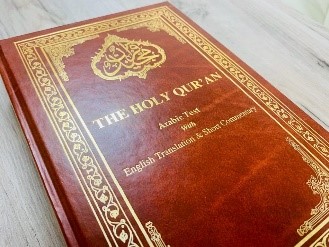 Watch this video and read through this PowerPoint about The Qur’an - the Holy book for Muslims.
Watch this video and read through this PowerPoint about The Qur’an - the Holy book for Muslims.
Think about what you have learnt from the video and PowerPoint.
- Write down 3 things you have learnt
- Write a question you still have about the Qur’an
- Think about why the Qur’an is special to Muslims
- Write your own set of rules that would help to make the world a better place
PSHE – Independence

- Think about how your life has changed since you were a baby. What can you do now that you couldn’t do when you were younger? Draw pictures to show your changes.
- Think about going into the Junior school. Make a list of things you will need to become more independent with.
- What would you like to get better at?
Science – Rocket Science
Use this sheet to have a go at some Rocket Science experiments at home.
PE –
The School Games Challenges have officially begun and we would like as many of you as possible to represent TEAM BOLDMERE!
The School Games Challenges are a collection of ongoing challenges linked to the School Games developed by the Birmingham School Games Organisers and Sport Birmingham.
The School Games is a National Initiative open to any young person. It forms part of the legacy work after the London 2012 Olympics and is an opportunity for young people to play, compete and represent their school in a wide range of sports and activities
Anyone can have a go at a challenge but you must be between 4-16 years old to submit results and attend a Birmingham Educational Institution. This is a great way of keeping fit and active, whilst having lots of fun!
Please refer to the newsletter for further information on how to take part.
ARCHIVED
Updated Year 2 Home Learning Resources – 22.06.20
Maths
Daily - White Rose maths session.
Daily maths session including a video and follow up questions/ activities. All resources will be saved onto our home learning page and accessed below. We do not expect you to complete every task here, however, each ‘step’ builds on from the next so work through them in the right order at your own pace.
Click here to go to White Rose Year 2 Home Learning
Week commencing 22nd June – Please remember to ignore the dates and complete the steps in order as the ‘small steps’ follow a sequence of lessons/concepts. If you have followed the sequence of lessons so far that we have set for home learning, then you should now be onto Summer Term Week 6. All other resources for previous/ following weeks can be found on our KS1 Mathematics curriculum page.
Week 1: Summer Term Week 6
Lesson 1 – The 10 times-table
Lesson 2 – Sharing
Lesson 3 – Grouping
Lesson 4 – Odd and even numbers
Lesson 5 – Friday challenge
Please find below the activity sheets for each day. The videos can still be accessed by following the White Rose link above.
White Rose Year 2 - Week 6
Weekly- Once you have completed the White Rose activities, have a go at your Mathletics challenge that your teacher has set for you at the end of each week.
Extras:
Daily – Click here to have a go at the White Rose ‘Problem of the Day’. Can you explain how you solved the problem?
English – Writing
Charlie and the Chocolate Factory

You will continue to receive ParentMails with chapter updates of ‘Charlie and the Chocolate Factory' so your child can enjoy followinf the story. However, our writing activities for the next couple of weeks will now focus on the Vivien French book ‘Oliver’s Vegetables’.
Oliver’s Vegetables
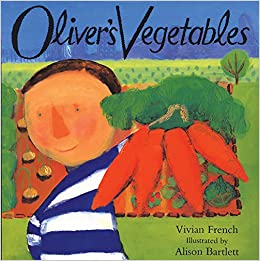
Watch the video clip of Mrs Perez reading Oliver’s Vegetables, which you should have received via ParentMail.
- Last week you made predictions about the story using the front cover to help.
- Were your predictions correct? Why/ why not?
Comprehension Questions:
- Have a go at these retrieval and inference type questions about the story.
Oliver’s Vegetable Diary:
- Use the book to help you complete a diary for Oliver and record which vegetables he ate on which day. Can you also write a description about the vegetable? You could use this template or create your own.
Poetry:
- Vegetable poem - Write down your ideas and some exciting vocabulary that you can use to help you write your poem all about vegetables! What do you love most about vegetables? What is your favourite vegetable?
- Using your vocabulary and ideas that you wrote down, create your own VEGETABLE acrostic poem. Here is an example to help you.

V – Very good for your body
E – Eat five a day
G – Grow your own in the garden
E – Enjoy a delicious bowl of pea soup
T – Tasty treats for you to eat
A – Air, water, soil and sunlight to help them grow
B – Broccoli is my favourite
L – Lots of vitamins to keep you healthy
E – Each day I try to eat as many as I can
S – Sow the seeds watch them grow
Other writing activities:
William Morris
One of the founders of the Arts and Craft movement was William Morris. He was very good at designing beautiful wallpaper, decorative glass and murals, many of which are still popular today. He once said that you should ‘Have nothing in your houses that you do not know to be useful or believe to be beautiful.'
 The Arts and Craft movement favoured quality over quantity and hand crafted items rather than mass produced, machine made goods, and sought to replace the mundane machine with specialised craftsmen, hand painted ornamentation and human personality in design – essentially quality over quantity.
The Arts and Craft movement favoured quality over quantity and hand crafted items rather than mass produced, machine made goods, and sought to replace the mundane machine with specialised craftsmen, hand painted ornamentation and human personality in design – essentially quality over quantity.
Listen to the Podcast about Art and Craft homes in London
- Write down 5 facts you can remember about William Morris.
- ‘Have nothing in your houses that you do not know to be useful or believe to be beautiful’. – What do you think this means? Write an explanation.
- ‘Quality over quantity’ – can you put this phrase into a sentence?
Spelling
Ask a grown up to read these sentences to you, have a go at writing them down without looking. Think about your capital letters, full stops and spellings. They all include Year 2 common exception words.
- I am going to the park after I have done my homework.
- The water in my bath was far too cold.
- Could you fold the clothes up please?
- How can you improve your work to make it even better?
- What an old picture that is!
- What a fast car they have!
- Open the door!
- Do not walk on the grass!
Can you put these common exception words into your own sentences?
- Father
- Behind
- Path
- People
- Child
- Sugar
- Fancy Letters – Write each of the Year 2 Common Exception Words using fancy writing. Your letters could be curly or dotty…or whatever you decide!

English – Reading
- Here are some reading activities for you to have a go at:
- Complete this 60 second read and answer the comprehension questions.
- Read a book of your choice by yourself. Go on a sound hunt to find the sound ‘ay/ai/a-e’ - how many words can you find? Make a list.
- Write a set of comprehension questions for your favourite book at home.
- Pick your favourite character from a story. Draw and describe them, explaining why you like them.
- Pick a topic that interests you and read the fiction and non-fiction book. Complete the activities that go with it – click here
- Choose and read a book of your choice on Oxford Owl.
Foundation subjects:
Geography – Local walk: human features
As many of you have been going for a daily walk, we would like to see you use your Geographical skills to select and map your route. You could also spot interesting human features along the way.
Login to Digimap for Schools at https://digimapforschools.edina.ac.uk/login using the schools details:
Username: boldmere password: clerds0992
On the main screen, use the search box to search for your postcode.
A map of your home and your local area will appear. Now you can choose a route that you would like to take on your walk. You can print off your map to take with you on your walk by clicking on the ‘print’ function.
Take a pencil with you and mark each of the human features that you come across. These may include: a house, road, shop, train track etc.
If you would like to take photographs of the human features that you come across, these could be uploaded to your map later on or you could draw the features on paper, cut them out and add them to your map. You could even create a key to match the symbols that you have included.
If you have chosen to take photographs, when you return from your walk, you could ask an adult to help you to upload the photos. To do this, select the camera icon, and then click on your map in the position you would like the picture to go.
History – Victorian Food
Look at the images of typical Victorian food and read the facts about Victorian food by clicking here
Have a go at creating your own menu for a Victorian feast here
Select your background, number of courses and number of dishes and then use the information you have read about Victorian food or use the ‘Browse Recipes’ tab to create or select your dishes.
You may even like to have a go at cooking some of the recipes yourself!
Art & Design – William Morris – Sketching
Revisit the PowerPoint about William Morris and read the fact file about Morris’ work as an artist.
Activity 1 – Sketch a leaf or flower in the style of William Morris (Use the example as an idea of how you may want your sketch to look)
Activity 2 – Complete a William Morris mindfulness colouring sheet.
Music
Have a browse at these websites and choose an activity you like:
BBC Primary Music – Video Resources (KS1) - Primary Music takes a cross-curricular approach by exploring lots of different KS1 topics through music. There are opportunities for your child to sing, take part in music activities, appraise music and compose their own music.
BBC Physical Education - Music (KS1) - Dances for each of the four elements (Earth, fire, air & water). These dances have been choreographed to different pieces of classical music including.
Religious Education – Sikhism
Watch this video and read through this PowerPoint about The Guru Granth Sahib Sikh Holy book.
Think about what you have learnt from the video and PowerPoint. Use the the template to help you to think about and draw something that is precious to you. Why is it so precious? How do you make sure that you look after and protect your precious object?
PSHE – Resilience
Ask a grown up to read you this story about 'Stickability’, then have a go at answering these questions:
- How did Jay feel about going to Grandma’s house?
- What was he looking forward to doing?
- Grandma talked to Jay about something she had to learn. What did she tell him?
- Grandma said she needed ‘Stickability’. What do you think she meant?
- Have you ever felt like Jay when you were trying to do something new?
- Do you like trying to do new things?
- What new things have you learnt to do?
- Can you think of anything you’ve done that you found hard? What did you do?
- What does it mean when we say ‘I’m stuck’?
Science – Regrowing Vegetables
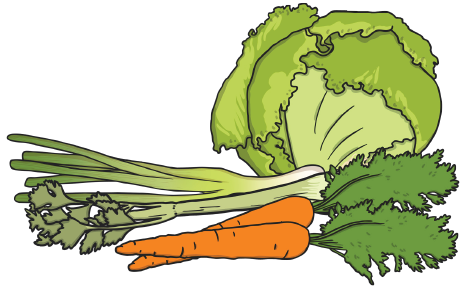
You will need:
- Water
- Bowls
- Carrot
- Celery
- Romaine lettuce
- Spring onion
- Knife
Use this sheet and follow the instructions to help you regrow your own vegetables at home!
PE -
Have a go at some of the great Go Noodle videos created by child development experts. They are a great way to practise movement and mindfulness! There are lots of fun videos and channels to choose from
ARCHIVED
Updated Year 2 Home Learning Resources – 15.06.20
We have put together the following timetable as a suggestion for how you may wish to structure the week. This is by no means compulsory and just a suggestion for how to structure and balance focusing on different subjects throughout the day/ week.
Maths
Daily - White Rose maths session.
Daily maths session including a video and follow up questions/ activities. All resources will be saved onto our home learning page and accessed below. We do not expect you to complete every task here, however, each ‘step’ builds on from the next so work through them in the right order at your own pace.
Click here to go to White Rose Year 2 Home Learning
Week commencing 15th June – Please remember to ignore the dates and complete the steps in order as the ‘small steps’ follow a sequence of lessons/concepts. If you have followed the sequence of lessons so far that we have set for home learning, then you should now be onto Summer Term Week 5. All other resources for previous/ following weeks can be found on our KS1 Mathematics curriculum page.
Week 1: Summer Term Week 5
Lesson 1 – Multiplication sentences using the x symbol
Lesson 2 – Use arrays
Lesson 3 – The 2 times-table
Lesson 4 – The 5 times-table
Lesson 5 – Friday challenge
Please find below the activity sheets for each day. The videos can still be accessed by following the White Rose link above.
White Rose Year 2 - Week 5
Weekly- Once you have completed the White Rose activities, have a go at your Mathletics challenge that your teacher has set for you at the end of each week.
Extras:
Daily – Click here to have a go at the White Rose ‘Problem of the Day’. Can you explain how you solved the problem?
English – Writing
Activities have been provided based on Charlie and the Chocolate Factory and alternative activities have been provided too for those who are not following the story/ wish to have a go at something else instead.
Charlie and the Chocolate Factory

Chapter 8
Below there are some words that were used in Chapter 8. With some help from a grown-up, find out what these words mean. You could have a look in a dictionary or on the internet. Add these words to your Charlie and the Chocolate Factory dictionary of words and write what they mean.
Adore – ‘I just adore gum. I can’t do without it.’
Annoyed – ‘Young Mike Teavee, the lucky winner, seemed extremely annoyed by the whole business.
Famous – ‘The famous girl was standing on a chair in the living room waving the Golden Ticket madly at arms length.’
Ferociously – ‘It was not easy to hear all that she said because she was chewing so ferociously upon a piece of gum at the same time.’
Criticise – ‘Who’s she to criticise, anyway, because if you ask me, I’d say that her jaws are going up and down almost as much as mine are just from yelling at me every minute of the day.’
Yelling - ‘Her jaws are going up and down almost as much as mine are just from yelling at me every minute of the day.’
Trampled – “Now, Violet,” Mrs Beauregarde said from a far corner of the room where she was standing on the piano to avoid being trampled by the mob.’
Possession – ‘It’s my most treasured possession now, this piece of gum is.’
Expensive – ‘You get the best results with women who have expensive gloves on.
Despicable – “Despicable!” said Grandma Georgina.
Crammed – ‘The Teavee household was crammed, like all the others, with excited visitors.’
Challenge: Can you write your own sentences using these words?
After listening to Chapter 9
In this chapter, Grandpa Joe gives Charlie the only money he has left to buy another chocolate bar so he can try and win a golden ticket.
Grandpa Joe is extremely kind towards Charlie, giving him money he can’t really afford to spare to help him.
Can you think of a time you have been kind helping somebody? Has somebody ever been extremely kind to you like Grandpa Joe was?
Write about what happened and how it made you feel.
Other writing activities:
William Morris
Last week you were shown this picture and asked to think of questions to find out more about the man.

Did you find out who he was?
This man is called William Morris and he was a famous Victorian artist, designer and craftsman. Think of some questions using who, what, where, when, why and how that you could ask to find out more about him and his work. E.g.
- What did you design?
- Where can I find your art and designs?
You will find some links in the Art & Design section to find out more about William Morris.
Oliver’s Vegetables:
Look at the cover of this picture book. Make a prediction about the story using the front cover to help you.
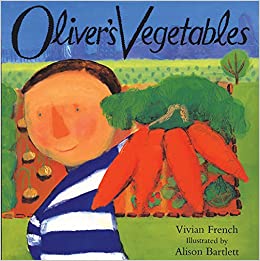
Now read the blurb:
‘Do you like chips? Oliver does. In fact, he won't eat anything else - until he plays a game with his grandpa. Whatever vegetable Oliver finds in the garden, he must eat.’

- Why do you think Oliver only eats chips?
- What vegetables do you think he will find?
- Do you think he will eat these? Why?
Use 'because' to explain your thinking.
Spelling
Ask a grown-up to read these sentences to you. Have a go at writing them down without looking. Think about your capital letters, full stops and spellings. They all include Year 2 common exception words.
- There are lots of kind and helpful children in our school.
- My clothes got very dirty in the garden when I was digging the plants up.
- Would you like to come for tea at my house?
- Can you find both of my shoes for me?
- What a beautiful bunch of flowers they are!
- What a busy day I had yesterday!
- Do not break the glass.
- You must not climb on the wall.
Can you put these common exception words into your own sentences?
- Floor
- Because
- Pretty
- Parents
- Christmas
- Should
Have a go at spelling these words correctly without looking at your word mat.
Word search - Can you make your own word search hiding as many of the Year 2 common exception words as you can?

English – Reading
- Here are some reading activities for you to have a go at:
- Complete a 60 second read about Victorian toys and answer the comprehension questions.
- Read a book of your choice by yourself or with a family member. You could take it in turns to read a page each.
- Watch a bed time story (Via Parent Mail) and retell the story to someone else
- Interview a family member about their favourite books
- Pick a topic that interests you and read the fiction and non-fiction book. Complete the activities that go with it – click here
- Choose and read a book of your choice on Oxford Owl
Foundation subjects
Geography
Visit the BBC weather website. Choose Salvador in Brazil as your location and search the weather for the next 5 days. Use the weather report sheet to share your findings. You can draw a symbol to describe the weather on that day, find the top temperature and write a brief description of the weather.

- What did you notice about the weather over the 5 days?
- Which day was the warmest?
- Which day was the coolest?
- How many days did it rain?
- Is this weather typical of the season? How do you know?
- Compare this forecast to UK forecast – what do you notice?
Have a go at our Boldmere Explorers Project. This time we are exploring Asia!
History – Clothes
Read through this PowerPoint on Victorian clothes
Find out about the type of clothes children would have worn in Victorian times.
How do they compare to the clothes that you may wear today?

You can use this sheet to help you compare.
Art & Design
William Morris
Watch this video and read through the PowerPoint to learn about William Morris. Look at his designs.
- Which is your favourite design?
- Why do you like this design?
- What colours have been used?
- What plants can you see?
- Can you see any animals?
Music
Have a browse at these websites and choose an activity you like:
BBC Bring the Noise – Home Learning (EYFS & KS1) - Bring the noise have produced some simple ideas which will help keep your little ones occupied while encouraging them to explore and learn about music.
BBC Primary Music – Video Resources (KS1) - Primary Music takes a cross-curricular approach by exploring lots of different KS1 topics through music. There are opportunities for your child to sing, take part in music activities, appraise music and compose their own music.
BBC Physical Education - Music (KS1) - Dances for each of the four elements (Earth, fire, air & water). These dances have been choreographed to different pieces of classical music including.
The Beat Goes On – Learning body percussion (KS1) - is a collection of body percussion videos. The founder of this company, Ollie Tunmer (a former cast member of the hit show STOMP) will be streaming a live body percussion workshop every day at 11am on his YouTube channel. No instruments required!
Religious Education
Hinduism
Use this video to help you learn about Hinduism. Create a fact file about what you have learnt.
PSHE – Resilience
Read the story – ‘The best dress ever’
Think about how Zid showed resilience.
How did Yoff and Mab help Zid?
Use the story sequencing sheet to help you sequence the story or have a go at writing your own story about resilience.
Science – Dancing Raisins
Investigate what happens to the raisins in the experiment!
Make a prediction about what will happen to the raisins when you drop them in the water and explain why you think this. Draw a table to record your results.
You will need
- Raisins
- Still water
- Fizzy water
- Plastic cups
ARCHIVED HOME LEARNING RESOURCES
Updated Year 2 Home Learning Resources – 08.06.20
Year 2 suggested timetable - 08.06.20
Maths
Daily - White Rose maths session.
Daily maths session including a video and follow up questions/ activities. All resources will be saved onto our home learning page and accessed below. We
Week 1: Summer Term Week 4
Lesson 1 – Adding and subtracting tens
Lesson 2 – Add 2-digit numbers
Lesson 3 – Subtract 2-digit numbers
Lesson 4 – Bonds to 100 (tens and ones)
Lesson 5 – Friday challenge
Please find below the activity sheets for each day. The videos can still be accessed by following the White Rose link above.
White Rose Year 2 - Week 4
Weekly- Once you have completed the White Rose activities, have a go at your Mathletics challenge that your teacher has set for you at the end of each week.
Extras:
Daily – Click here to have a go at the White Rose ‘Problem of the Day’. Can you explain how you solved the problem?
English – Writing
Charlie and the Chocolate Factory
Before listening to chapter 7 – Charlie’s Birthday
1 - At the end of chapter 6, it was the day before Charlie's birthday. He was excited to wake up the next morning because his Mum told him that his family had got him a Wonka chocolate bar for his birthday.

Make a prediction. What do you think is going to happen in chapter 7? Why do you think that? Use 'because' to explain.
After listening to chapter 7 – Charlie’s Birthday
2 - In chapter 7, Charlie got a bar of Wonka's Whipple-scrumptious fudgemallow delight for his birthday. Fill out this thoughts and feelings sheet
Before opening the chocolate bar:
- What do you think Charlie was thinking?
- How do you think Charlie felt? Why?
- What do you think he might say?
After opening the chocolate bar:
- What do you think Charlie was thinking?
- How do you think Charlie felt? Why?
- What do you think he might say?
After listening to chapter 8 – Two More Golden Tickets Found
3 - In chapter 8, we met the next two finders of the golden tickets - Violet Beauregarde and Mike Teavee. Watch this video clip of Violet Beauregarde. Here is the text too to remind you.


Create a word bank of vocabulary to describe Violet Beauregarde.
What do we know about her from the text? Create a table for your vocabulary and split it up into words that describe her appearance - what she looks like (things we can see) and her personality (things we can’t see)
|
Appearance |
Personality |
|
|
|
4 - Using your word bank that you made for Violet Beauregarde, write sentences to describe her. You could even draw your own picture too!
Then answer these questions…
Try to use the word because in your sentences to explain your answers. E.g. I think Violet Beauregarde is......because....
- Do you think Violet Beauregarde is a nice girl? Why/ why not?
- Would you like to be her friend? Why/ why not?
- Do you like anything as much as Violet Beauregarde likes gum? Tell me about something you really, really like.
Other writing activities:
1 - Have a look at this photograph. This is somebody we are going to be learning about next week. Write some questions to find out more information about him. What do you want to know? What would you like to ask him if you could? Remember to punctuate your questions with a question mark - ?
Think about using different words to start your question with:
who, what, where, when, why, how, do, does

2 - Write your own story! Fold a piece of paper (or several pieces of paper) in half to create your own story book. You can work on your story throughout the week.
- Plan your own characters and setting for your story.
- Create your own story map/ story board for your story - plan the beginning, middle and end.
- Give your story a title and design the front cover. Don't forget to write the author on the front too!
- Write the beginning of your story.
- Write the middle of your story.
- Write the end of your story.
- Check your story. Read it through and make corrections if you spot any mistakes.
- Write a blurb for your story.
- Get a family member to read your story. They could look at the front cover and the title first and make a prediction about what might happen!
Poetry
- Summer poem - Write down your ideas and some exciting vocabulary that you can use to help you write your poem all about summer! What do you love most about Summer?
- Using your vocabulary and ideas that you wrote down from the pictures, create your own SUMMER acrostic poem. Here is an example to help you. You could use this template.
S- Sunlight beams down and warms my face
U- Umbrellas for shade if it gets too hot
M- My favourite thing to do is play in the garden!
M- My paddling pool is out – splash, splash, splash!
E- Eating yummy ice cream to keep me cool
R- Roses and daisies and lots of beautiful flowers growing.
English – Reading
Here are some reading activities for you to have a go at:
- Complete a 60 second read and answer the comprehension questions. You can find lots of them by clicking here
- Read a book of your choice by yourself or with a family member. You could take it in turns to read a page each.
- Pick a topic that interests you and read the fiction and non-fiction book. Complete the activities that go with it – click here
- Choose and read a book of your choice on Oxford Owl.
- Listen to a chapter of ‘Charlie and the Chocolate Factory’ (Link will be sent via ParentMail)
Foundation subjects
Science – Awe and wonder! Cornflour slime
Cornflour slime science experiment
Investigate what happens when you mix cornflour, water and food colouring! Have a look at the prompt card and answer the questions before, during and after your experiment. When you make a prediction, explain why you think this. Draw a table to record your results.
You will need
- A large bowl
- Food colouring
- 200ml water
- 200-300g cornflour
History -
Visit BBC Bitesize - What were houses like 100 years ago? to read all about what houses were like 100 years ago. Explore the living room, kitchen, bathroom and bedroom in the interactive house.

Take a look through this PowerPoint about Victorian homes.
- What were Victorian Homes like? – Did they have fires/ garages/ an attic/ a bathroom?
- How did Victorian houses compare to houses today?
- What were the main similarities/ differences.
Draw and label a Victorian house using the information you have read. Then draw a modern day house and label the main features.
Geography
Visit the BBC weather website. Choose a UK location and look at the weather for the next 5 days. Use this UK weather report sheet to share your findings. You can draw a symbol to describe the weather on that day, find the top temperature and write a brief description of the weather.
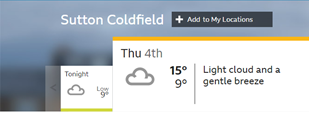
- What did you notice about the weather over the 5 days?
- Which day was the warmest?
- Which day was the coolest?
- How many days did it rain?
- Is this weather typical of the season? How do you know?
Have a go at our Boldmere Explorers Project. This time, we are exploring Africa!
.png)
Art & Design
Take a selfie or look into a mirror and have a go at sketching a self-portrait.
Use this video to help you think about perspective, proportion, shadow and texture when drawing your self-portrait.

You could add colour or shading for your hair, eyes and skin tone.
Computing -
Take a look here to have a go at the BBC Bitesize computing activities. There are lots of fun videos and activities to help you learn about coding and revisit algorithms. You can have a go at creating your own algorithms and solve puzzles.
Music
Have a browse at these websites and choose an activity you like:
BBC Bring the Noise – Home Learning (EYFS & KS1) - Bring the noise have produced some simple ideas which will help keep your little ones occupied while encouraging them to explore and learn about music.
The Beat Goes On – Learning body percussion (KS1) - is a collection of body percussion videos. The founder of this company, Ollie Tunmer (a former cast member of the hit show STOMP) will be streaming a live body percussion workshop every day at 11am on his YouTube channel. No instruments required!
Religious Education

Use this video about the Torah and this PowerPoint to help you learn about the Jewish Holy Book – The Torah. Create a fact file about what you have learnt.
PE -
Have a go at some of the great Go Noodle videos created by child development experts. They are a great way to practise movement and mindfulness! There are lots of fun videos and channels to choose from.
PSHE
Watch this video where Dennis and Minnie talk about resilience.
Look at this PowerPoint - read through the slides with an adult and discuss being brave, bounce-back-ability and how you can show resilience – make a list of your ideas and create a poster about being resilient.
Can you give an example of a time you have shown resilience?
Updated Year 2 Home Learning Resources – 01.06.20
We have put together the following timetable as a suggestion for how you may wish to structure the week. This is by no means compulsory and just a suggestion for how to structure and balance focusing on different subjects throughout the day/ week.
Year 2 suggested timetable - 01.06.20
Maths
Daily - White Rose maths session.
Daily maths session including a video and follow up questions/ activities. All resources will be saved onto our home learning page and accessed below. We do not expect you to complete every task here, however, each ‘step’ builds on from the next so work through them in the right order at your own pace.
Click here to go to White Rose Year 2 Home Learning
Week commencing 1st June – Please remember to ignore the dates and complete the steps in order as the ‘small steps’ follow a sequence of lessons/concepts. If you have followed the sequence of lessons so far that we have set for home learning, then you should now be onto Summer Term Week 3. Please find the activity sheets for each day and the video links for week 3 below. All other resources for previous/ following weeks can be found on our KS1 Mathematics curriculum page.
Week 1: Summer Term Week 3
Lesson 1 – Fact families addition and subtraction bonds to 20
Lesson 2 – Compare number sentences
Lesson 3 – Related facts
Lesson 4 – Add and subtract ones
Lesson 5 – Friday challenge/ Mathletics
White Rose Year 2 - Week 3
Weekly- Once you have completed the White Rose activities, have a go at your Mathletics challenge that your teacher has set for you at the end of each week.
Daily – Click here to have a go at the White Rose ‘Problem of the Day’. Can you explain how you solved the problem?
English – Writing
Activities have been provided based on Charlie and the Chocolate Factory and alternative activities have been provided too for those who are not following the story/ wish to have a go at something else instead.
Charlie and the Chocolate Factory

You will continue to receive ParentMails with chapter updates of ‘Charlie and the Chocolate Factory.’
After listening to chapter 6 – The First Two Finders
Watch this video clip of Augustus Gloop. Here is the text too to remind you.
.jpg)
1 – Create a word bank of vocabulary to describe Augustus Gloop – the first finder of a Golden Ticket. What do we know about him from the text? Create a table for your vocabulary and split it up into words that describe his appearance - what he looks like (things we can see) and his personality (things we can’t see)
|
Appearance |
Personality |
|
|
|
2 - Using your word bank that you made for Augustus Gloop, write sentences to describe him. You could even draw your own picture too!
Then answer these questions…
Try to use the word because in your sentences to explain your answers. E.g. I think Augustus Gloop is greedy because…..
- Do you think Augustus Gloop is a nice boy?
- Would you like to be his friend? Why/ why not?
- Do you think Augustus deserves to go into the chocolate factory? Why/why not?
3 – Below there are some words that were used in Chapter 3. With some help from a grown-up, find out what these words mean. You could have a look in a dictionary or on the internet. Create your own Charlie and the Chocolate Factory dictionary of words and write what they mean. We can add to this later on with new words we find!
Bulged – Great flabby folds of fat bulged from every part of his body.
Youth – A parade was being organised in honour of the famous youth.
Nourishment – “What I always say is, he wouldn’t go on eating like he does unless he needed nourishment, would he?”
Revolting – “What a revolting woman,” said Grandma Josephine.
Repulsive – “And what a repulsive boy,” said Grandma Georgina.
Frantically – The whole word seemed suddenly to be caught up in a mad chocolate-buying spree, everybody searching frantically for those precious remaining tickets.
Precious – The whole word seemed suddenly to be caught up in a mad chocolate-buying spree, everybody searching frantically for those precious remaining tickets.
Directly – Then I had them loaded on to trucks and sent directly to my own factory.
Yanking – I had every worker in the place yanking the paper off those bars of chocolate full speed ahead from morning till night.
Vowed – Well, I just hated to see my little girl feeling unhappy, so I vowed I would keep up the search until I’d got her what she wanted.
Challenge: Using your definitions, can you use these words in sentences of your own?
Other writing activities:
- Write a letter – Write a letter to your teacher telling us all about your half term! What did you get up to? What was your favourite thing that you did? We would love to hear about what you have been doing. Use this poster to remind you how to set out a letter.
Remember to write in past tense because it has already happened – don’t forget to use your ‘ed’ suffix!
- Write a new blurb for a book you have read. You could create your own new front cover and title for the story and write an exciting blurb based on what happens in the story.
- Design your own sports day race. Draw a picture of your race and label the equipment you need.
- Give your race a name
- Write a description of what happens in the race
- Write a set of instructions that someone can follow to take part in your race. Remember to use numbers for each instruction and imperative (bossy) verbs. Use these exercise imperative verbs to help you.
Poetry
- Summer poem - Write down your ideas and some exciting vocabulary that you can use to help you write your poem all about summer! What do you love most about Summer?
- Using your vocabulary and ideas that you wrote down from the pictures, create your own SUMMER acrostic poem. Here is an example to help you. You could use this template.
S- Sunlight beams down and warms my face
U- Umbrellas for shade if it gets too hot
M- My favourite thing to do is play in the garden!
M- My paddling pool is out – splash, splash, splash!
E- Eating yummy ice cream to keep me cool
R- Roses and daisies and lots of beautiful flowers growing.
English – Reading
Here are some reading activities for you to have a go at:
- Complete a 60 second read and answer the comprehension questions. You can find lots of them by clicking here
- Read a book of your choice by yourself or with a family member. You could take it in turns to read a page each.
- Have a go at the ‘Earth Science – Stars' - reading activity – You can also access this activity by clicking here and finding the activity under Week 2 - Day 8.
- Pick a topic that interests you and read the fiction and non-fiction book. Complete the activities that go with it – click here
- Choose and read a book of your choice on Oxford Owl.
- Listen to a chapter of ‘Charlie and the Chocolate Factory’ (Link will be sent via ParentMail)
Foundation subjects
Science – What will happen to the colours? – Awe and Wonder experiment
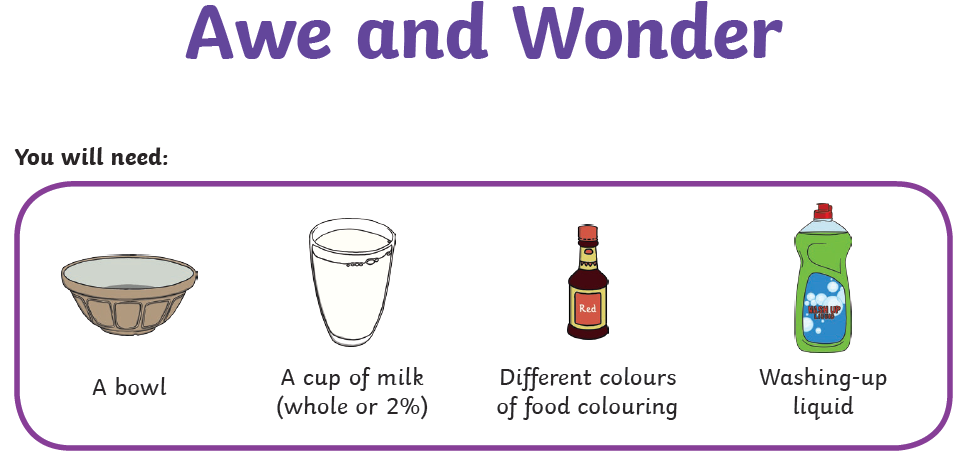
Awe and Wonder Science experiment
Investigate what happens to the colours in the awe and wonder experiment! Have a look at the prompt card and answer the questions before, during and after your experiment. When you make a prediction, explain why you think this. Draw a table to record your results.
You will need
- A bowl
- A cup of milk (whole milk)
- Different colours of food colouring
- Washing-up liquid
History –
The first Cadbury factory opened in the Victorian period. We are going to find out a little bit more about the Victorian times. Have a look at these photographs of inventions from the Victorian period. Look at the photographs. You should be able to find these things in and around your home. Compare them to the photographs. How have they changed over time?
- Photograph - camera
- Telephone
- Motor car
- Radio
- Bicycle
- Stamp
- Postbox
- Toilet
Have a discussion about these items with a family member.
- How have these things changed since the Victorian period?
- What is different about them? Is anything the same?
- Can you spot something that hasn’t changed much?
- What has changed a lot?
- What do you think it would have been like using these objects in the Victorian period?
Geography -
Comparing Brazil to where we live.
Revisit this PowerPoint about Brazil. Create a table comparing Brazil to where we live in the UK. Can you spot anything that is the same? Here is an example to help you.
|
|
Brazil |
The UK |
|
Where in the world? Continent |
|
|
|
Weather |
|
|
|
Food |
|
|
|
Celebrations |
|
|
|
Special places |
|
|
You might also think of your own things to compare!
Have a go at our Boldmere Explorers Project. This time, we are exploring Africa!
.png)
DT -
Evaluate the chocolate brownies that you made! Have a go at using this sheet to help you. We have used it lots of times before in school to evaluate our creations in DT.
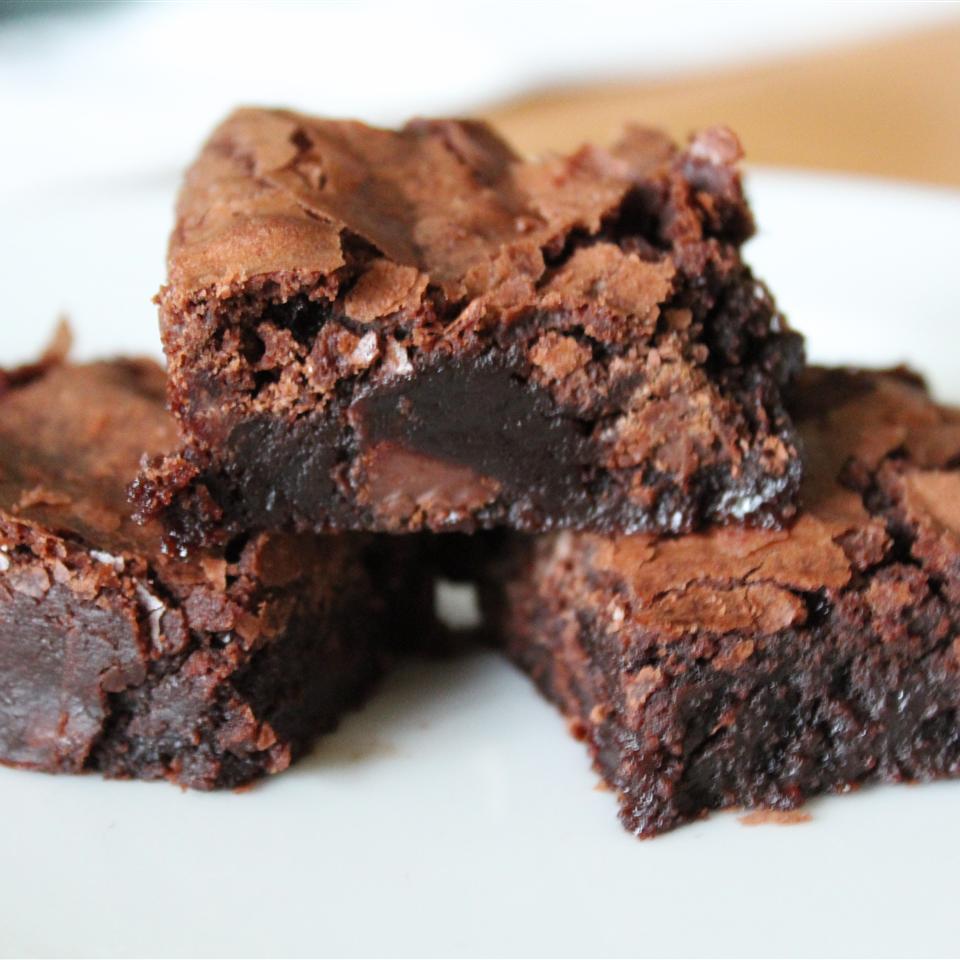
Art –
Practise your sketching skills.
Find some plants, flowers and leaves in your garden. Sit in the sunshine and sketch what you have found.
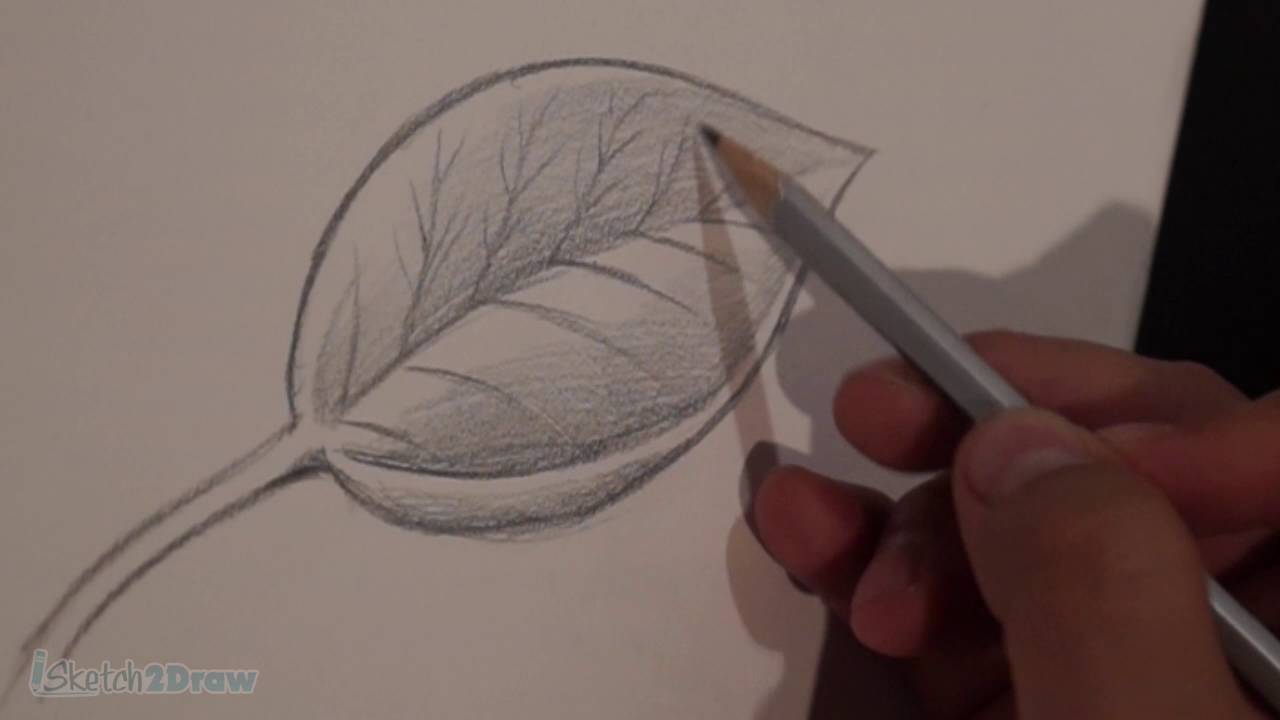

Take a look at Rob Biddulph - Draw with Rob on YouTube for some great tutorials on how to draw lots of fun pictures such as racing cars, superhero bears and animals.
Computing -
Take a look here to have a go at the BBC Bitesize computing activities. There are lots of fun videos and activities to help you learn about coding and revisit algorithms. You can have a go at creating your own algorithms and solve puzzles.
PE -
Create your own sports day at home e.g. pillow case race, wheelbarrow race, egg and spoon, race against your parents, create your own obstacle course.
You could also use the race you designed for your writing activity!
Please feel free to share your sports day pictures on our school Twitter account: @BoldmereSchools. We would love to see what you get up to!
Have a go at some of the great Go Noodle videos created by child development experts. They are a great way to practise movement and mindfulness! There are lots of fun videos and channels to choose from.
RE -
This half term we are thinking about beliefs and different religions. This week we want you to think about Christianity.
Have a look at this PowerPoint to find out about Christianity and the Bible.
Watch this video about the Bible in Christianity and why it is important for this Christian family.
Answer these questions:
- What is the Bible?
- Why is the Bible special for Christians?
- Write down 3 things you have learned.
- Write down a question you still have.
Music -
Practise your signing using Out of the Ark Music. This website contains lots of the songs that we use in assemblies. It also has activities to complete around the song which link with wellbeing.
PSHE–
Our value this half term is ‘resilience’. With a grown-up, can you find out what resilience means?
Watch the video of Miss Sandford reading the bedtime story ‘After the Fall (How Humpty Dumpty Got Back Up Again) – sent on Thursday 28th May.
How does Humpty Dumpty show resilience in the story? Why is he resilient?
Create a poster about resilience. What does resilience mean? Why is it important to be resilient? Think of a time when you have been resilient.
ARCHIVED HOME LEARNING RESOURCES:
Updated Year 2 Home Learning Resources – 11.05.20
We have put together the following timetable as a suggestion for how you may wish to structure the week. This is by no means compulsory and just a suggestion for how to structure and balance focusing on different subjects throughout the day/ week.
Year 2 Example Home Learning Timetable - 11/05/20
Maths
Daily - White Rose maths session.
Click here to go to White Rose Year 2 Home Learning
Week commencing 11th May – As the ‘small steps’ follow a sequence of lessons and concepts, it is important to complete the steps in order. Weeks 1 and 2 were completed over the previous 2 weeks, so we are now moving on to the ‘Summer Term’ blocks. These appear on the White Rose website as - Summer Term Week 1 (w/c 20th April) and Week 2 (w/c 27th April)
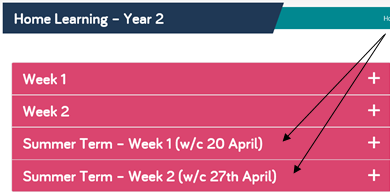
Week 1: Summer Term Week 1 Week 2: Summer Term Week 2
Lesson 1 – Find three quarters Lesson 1 – Compare lengths
Lesson 2 – Count in fractions Lesson 2 – Order lengths
Lesson 3 – Measure length (cm) Lesson 3 – Four operations with length
Lesson 4 – Measure length (m) Lesson 4 – Problem solving
Lesson 5 – Mathletics challenge Lesson 5 – Mathletics challenge
Please find the activity sheets for each day and the video links for week 1 and week 2 on our KS1 Mathematics curriculum page. All other previous resources can be found here too. The videos can also still be accessed by following the White Rose link above.
Year 2 White Rose Maths Resources - w/c 11/05/20 and 18/05/20
Weekly- Once you have completed the White Rose activities, have a go at your Mathletics challenge that your teacher has set for you at the end of each week.
Extras:
Daily – Click here to have a go at the White Rose ‘Problem of the Day’. Can you explain how you solved the problem?
Take a look here to see the scheme of learning for ‘Measurement: Length and Height’ for further ideas for questioning, reasoning and problem solving. It also gives you lots of great key mathematical vocabulary for this unit.
English – Writing
Charlie and the Chocolate Factory
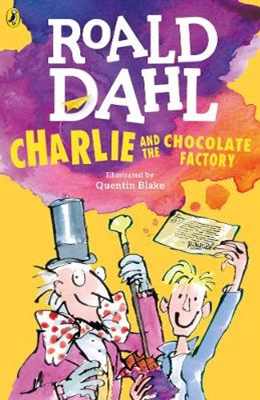
You will continue to receive ParentMails over the next 2 weeks with chapter updates of ‘Charlie and the Chocolate Factory.’
After listening to chapter 3 – Mr Wonka and the Indian Prince
In chapter 3, we read about Prince Pondicherry writing a letter to Mr Willy Wonka asking him to go to India and build him a castle made entirely out of chocolate.
It had one hundred rooms, and everything was made of either dark or light chocolate. The bricks were chocolate, and the cement holding them together was chocolate, and the windows were chocolate, and all the walls and ceilings were made of chocolate, so were the carpets and the pictures and the furniture and the beds; and when you turned the taps in the bathroom, hot chocolate came pouring out.
1 - Design your own bedroom made out of chocolate and sweets! Draw a picture of what you want your bedroom to look like and label all of the different sweets and chocolates that you have used. Be as creative as you can! You may have a lamp made out of a tall candy cane, a bed made out of a huge marshmallow, and a wardrobe made out of chocolate. Try to use some adjectives too – soft, fluffy marshmallow. Smooth, creamy chocolate.
2 – Write a letter to Mr Willy Wonka (just like Prince Pondicherry!) asking him to build you your bedroom made entirely out of chocolate and sweets. Remember to tell him exactly how you want your bedroom to look and what you want in it. Describe your bedroom carefully and use your design picture and labels to help you.
Use this poster to remind you how to set out a letter. Remember, you have written a letter before to Julia Donaldson.
After listening to chapter 4 – The Secret Workers
3 - Charlie has found out lots of information about Mr Willy Wonka and the Chocolate Factory from his grandparents, but Charlie has never met or even seen Mr Willy Wonka. Imagine the first time that Charlie meets Mr Willy Wonka. Can you write a conversation that they might have together? You have written a conversation before between James and the Snowman. Remember to try and use the 4 different sentence types and think about the punctuation you need to use. Use this poster and the example below to help you.
Charlie: Hello! My name is Charlie.
Willy Wonka: Hello Charlie. Nice to meet you. I’m Mr Willy Wonka.
Charlie: Is it really true that you have secret workers in your chocolate factory?
After listening to chapter 5 – The Golden Tickets
4 – Design and create your very own Golden Ticket! Write information and instructions on the front and back for the lucky winners.
You will need to write down the time and date, where the winners need to go, and instructions they need to follow. Here are some ideas.
|
Date: Monday 1st June 2020 Time: 12 o clock Place: The big, black iron gates outside the factory Instructions: Wear your best clothes. Do not be late. |
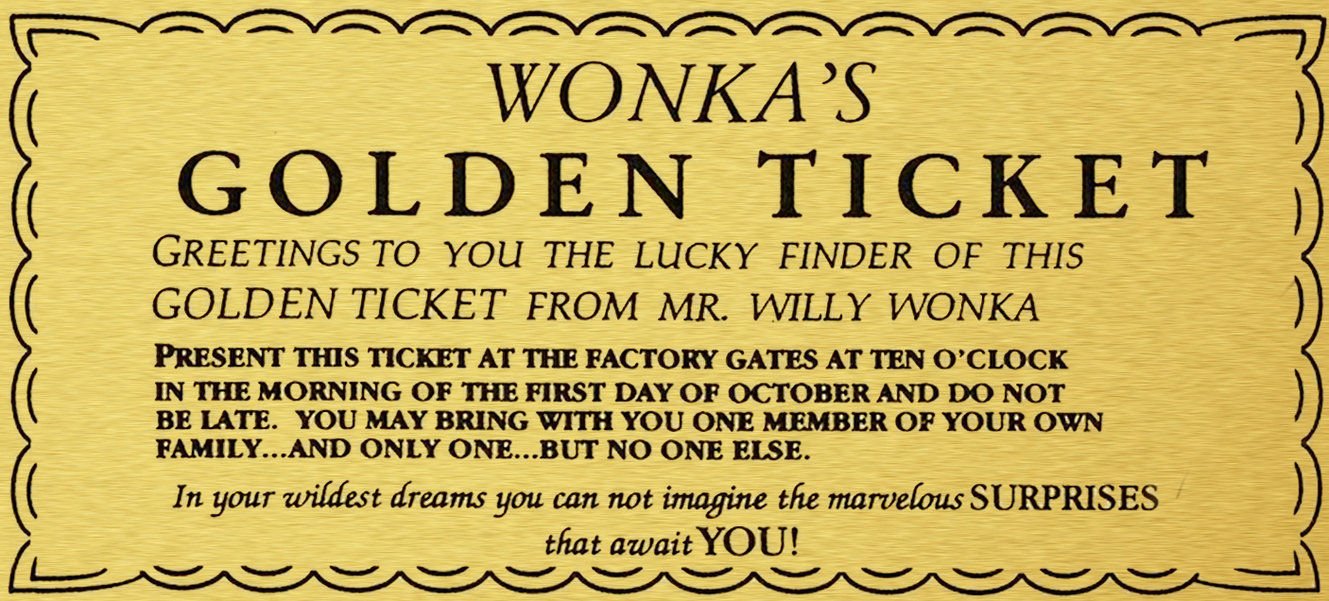
Other activities:
- Diary entry – Write a diary entry about your bank holiday weekend. Did you do anything special or exciting for VE day? Did you spend time outside enjoying the sunshine? Remember to write in the past tense because it has already happened. Dear diary,
- Practise spelling your year 2 common exception words correctly and writing them in sentences. Can you think of some sentences that have more than 1 common exception word in? How many common exception words can you use in one sentence?
- Write a book review based on a book you have read this week. Here is an example to help you.
- Design your own new chocolate or sweet that could be made in Willy Wonka’s factory. Create an advert for your very own chocolate bar or sweet. Remember to make it look yummy and exciting – you want people to buy it! You might want to give it a fun name and a catchy slogan. What is inside your chocolate/sweet? Where can you buy it? What does it taste like?
Poetry
1 - Look at the pictures below of chocolates and sweets. Write down your ideas and some exciting vocabulary that you can use to help you write your poem next time. Describe your senses – what can you - See? Touch? Taste? Smell? Feel?
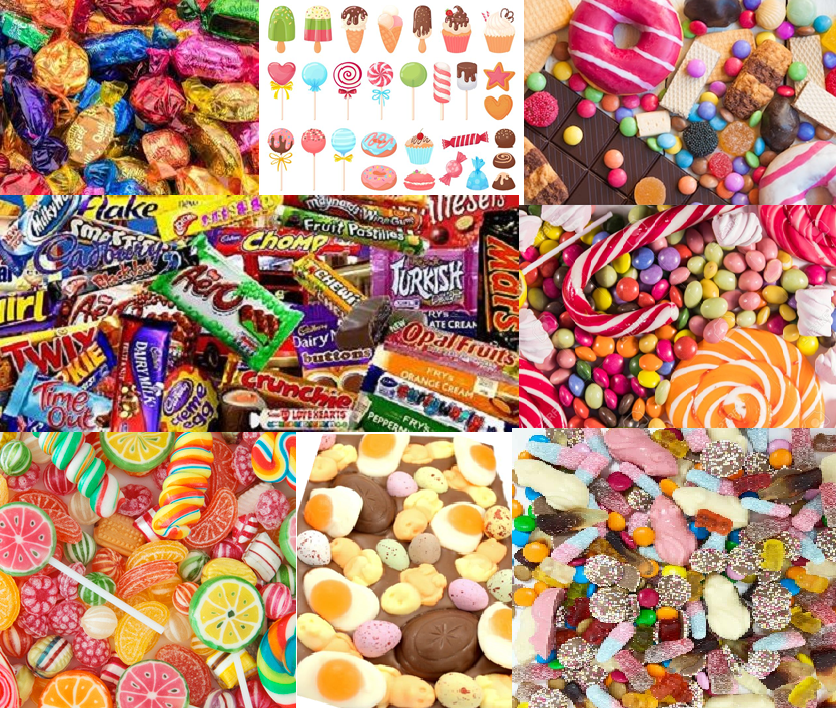
- Using your vocabulary and ideas that you wrote down from the pictures, create your own sweets and chocolate acrostic poem - click here for acrostic poem templates. Here is an example to help you.
C- Creamy milk chocolate bars are my favourite
H- How many bars could I eat in one go?
O- One, two, three, four. I love….
C- Chocolate! I think I’ll eat more
O- Oh so yummy. It’s out of this world
L- Lovely and delicious caramel all gooey inside
A - All different fillings, it’s so hard to decide!
T- Treats for you, treats for me
E- Everyone loves chocolate, it’s clear to see!
English – Reading
- Here are some reading activities for you to have a go at:
- Complete a 60 second read and answer the comprehension questions. You can find lots of them by clicking here
- Read a book of your choice by yourself or with a family member. You could take it in turns to read a page each.
- Have a go at the ‘Animals and Plants - Seashore’ reading activity - click here. You can also access this activity by clicking here and finding the activity under Week 4 - day 16.
- Have a go at the ‘Firefighters’ reading activity - click here. You can also access this activity by clicking here and finding the activity under Week 4 - day 20.
- Pick a topic that interests you and read the fiction and non-fiction book. Complete the activities that go with it – click here
- Choose and read a book of your choice on Oxford Owl.
- Listen to a chapter of ‘Charlie and the Chocolate Factory’ (Links for chapters 3, 4, and 5 will be sent via ParentMail)
Foundation subjects
Science –
Which material is the most suitable for the packaging of a chocolate bar?
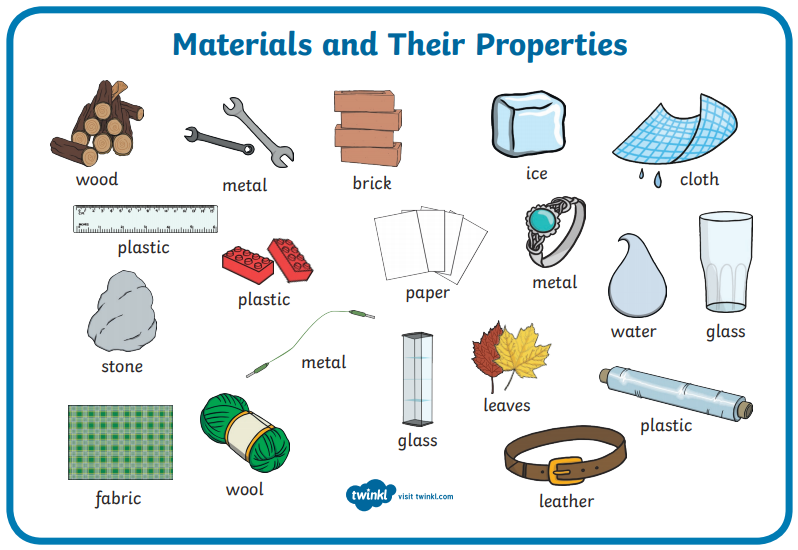
Investigate the best material for packaging your new chocolate bar. We have investigated materials last term. Look at the materials above and see if you can find them around your home. Make a prediction first about whether you think it will be suitable. Feel the material and use these word mats to describe the properties. Do you think it would be suitable for packaging chocolate? Why/ why not? Draw a table to record your results. Here is an example to help you.

After my investigation, I think the most suitable material would be…… because…….
History –
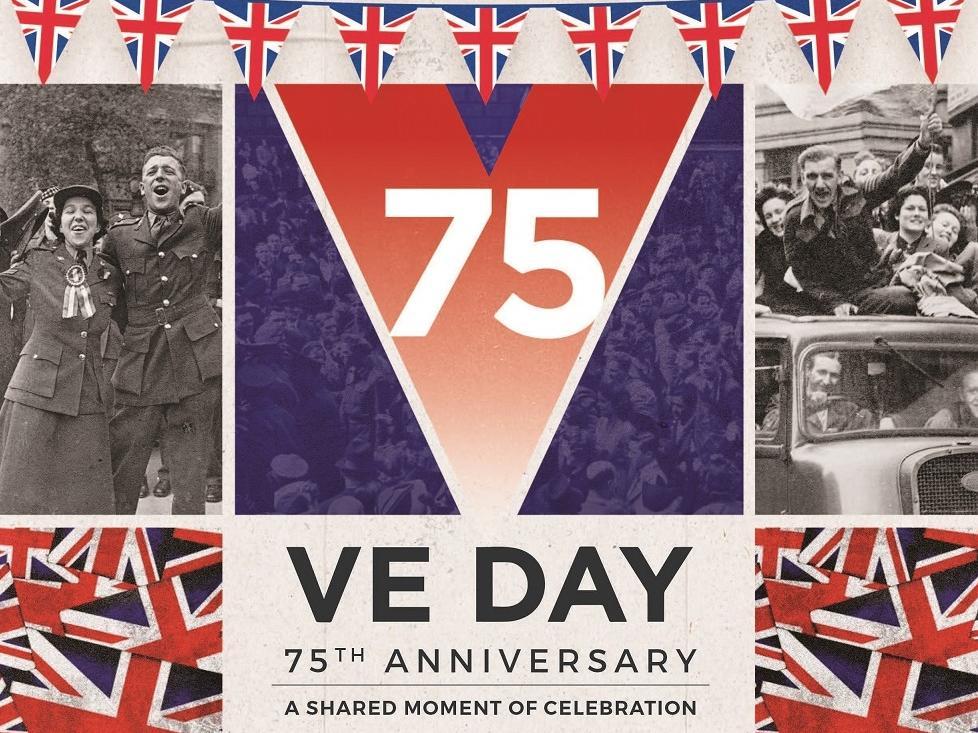
Last week, we celebrated VE day (75 years) Take a look here at our VE day learning resources on our school website. You will find a diary entry written by the Headteacher of Boldmere Infant and Nursery School in 1942! Read the diary entry with a grown-up (the handwriting is quite tricky to read!)
What questions would you ask the Headteacher? Write a list of questions you would ask to find out more information about what happened.
You could start your questions with - who, what, where, when, why, how, do, have.
Here are some other VE day activities on the page you could have a go at:
- Design your own medal
- VE day wordsearch
- Make your own Spitfire Glider
- Design your own teacup for celebrating VE day
- Create your own flag
- You could also have a go at this Captain Tom Moore reading comprehension.
- Write a letter to Captain Tom Moore. What would you like to say to him?
Geography -
What is it like in Brazil where cocoa beans grow?
Look at this PowerPoint to find out about Brazil. Create a poster or a fact file all about Brazil using what you know - you could draw pictures and write about
- Where Brazil is – which continent is it in?
- The weather in Brazil
- What food is produced and grown in Brazil
- Special places and celebrations in Brazil
- Fun facts!
Boldmere Explorers - Europe
Join in with our exciting 'Boldmere Explorers' project! Click here to go to our Explorers page, where we are now looking at the continent Europe. There are lots of fun activities for you to have a go at!
DT -
Have a go at making you own chocolate brownies! Here is a recipe you can follow, or your parents might have a different recipe at home.
Next time, you are going to be evaluating your product so make sure you take a photograph once you have finished before eating them all up!
Art –
Have a go at creating your own sweets and chocolate 'silhouette' painting. We created silhouette paintings before when we learnt about The Great Fire of London. Have a look at the picture below to remind you.
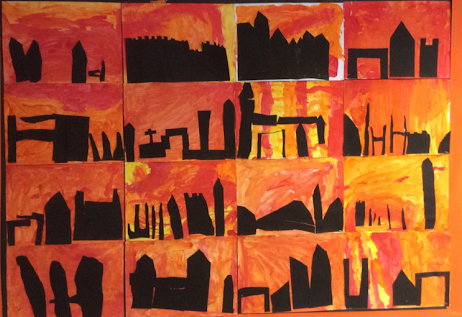
Try creating your own background using different coloured paints. Let it dry, and use paper to draw and cut out different shaped sweets and chocolates. Once your painting is dry, stick on your sweets and chocolates to create your silhouette painting. Here is an example to show you.
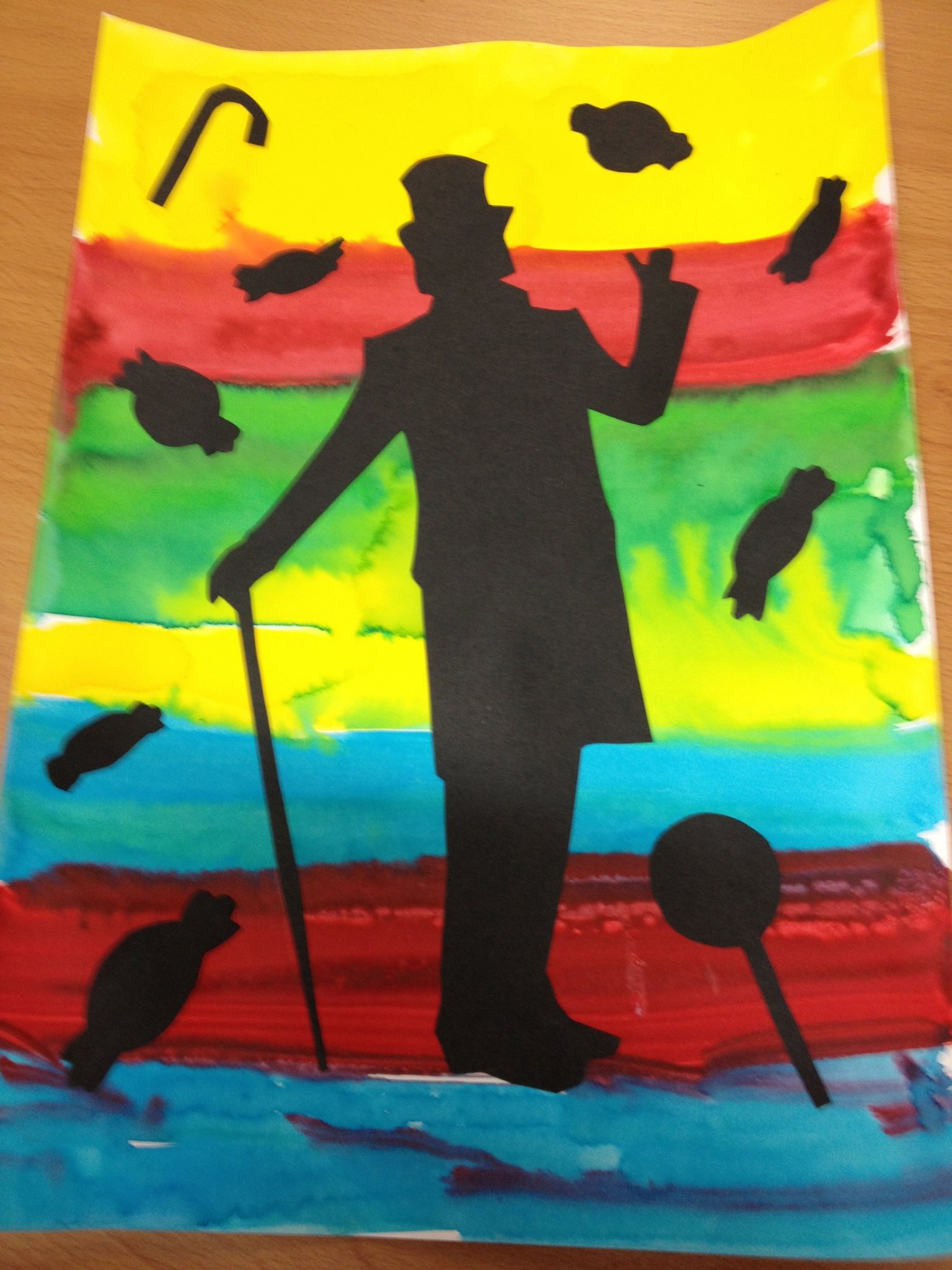
Take a look at Rob Biddulph - Draw with Rob on YouTube for some great tutorials on how to draw lots of fun pictures such as racing cars, superhero bears and animals.
Computing -
Take a look here to have a go at the BBC Bitesize computing activities. There are lots of fun videos and activities to help you learn about coding and revisit algorithms. You can have a go at creating your own algorithms and try to solve the puzzles.
PE -
Have a go at some of the great Go Noodle videos created by child development experts. They are a great way to practise movement and mindfulness! There are lots of fun videos and channels to choose from.
RE –
Ramadan - 23rd April - 23rd May
Ramadan is a very important time in the Islamic calendar, and Muslims all over the world take part.
Take a look here for some information, facts and videos all about Ramadan. Once you have had a look, you can have a go at this quiz
Music –
Listen to and appraise some of the songs from 'Charlie and the Chocolate factory.' Think about which instruments you can hear and the tempo, pitch and dynamics of the music.
Click here for the songs and vocabulary
Year 2 Home Learning Resources - 11/5/20
Please see below links for:
- website links – free resources and activities available
- year group word list
- phonic sound mats
The home learning grid provides suggested stand-alone activities in addition to the suggestions above that can be completed at home, some of which can be completed independently and some of which you can enjoy working on together. We have also collated some ‘Boredom Buster’ activities (for moments in need!) Please refer to our website links for some excellent free resources that are available to you also.
Please be aware that these activities are suggested and not compulsory. However, we hope they provide lots of opportunities for fun and enjoyment at home.
We will celebrate any work completed at home with the children once school re-opens.
Please feel free to tweet us @BoldmereSchools. We would love to see all of the fantastic work you have been doing at home!
Best wishes,
Year 2 Team
Year 2 Home Learning Resources
.png)